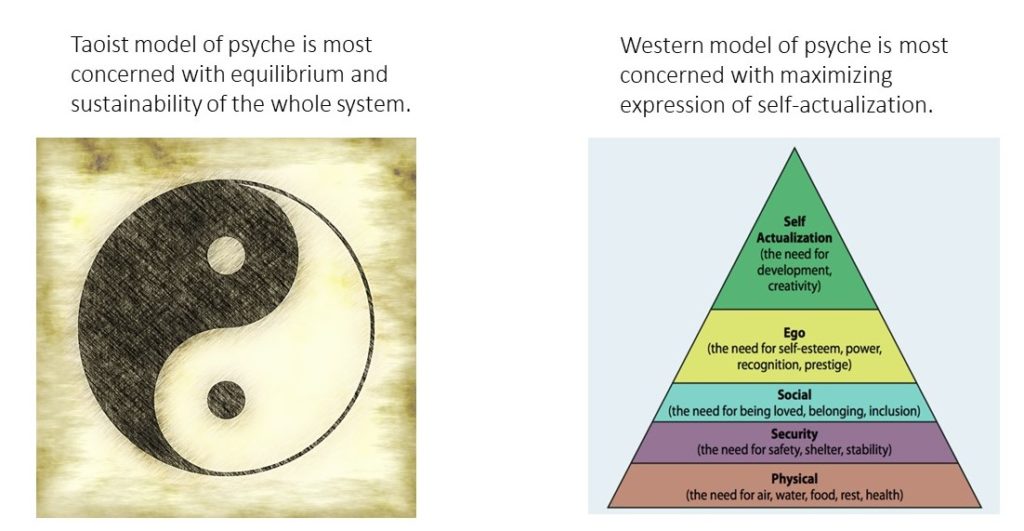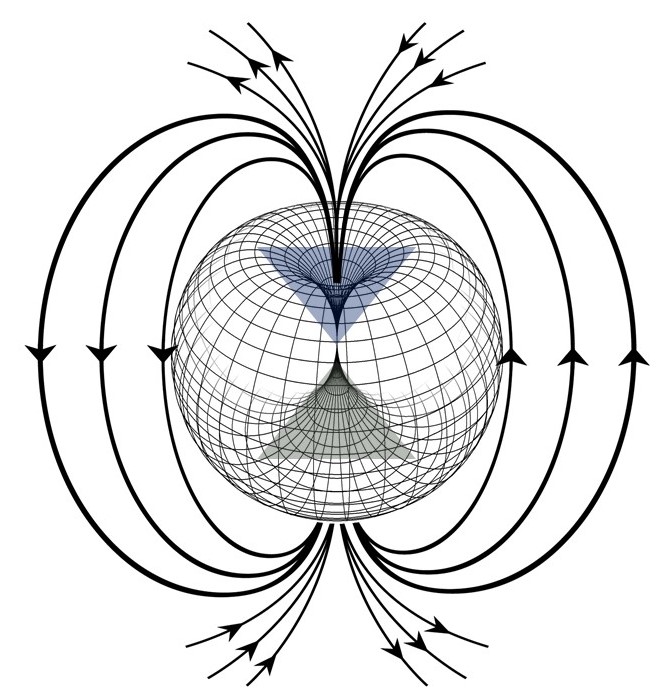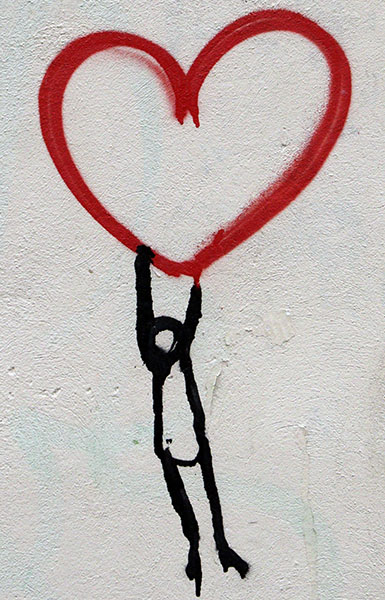Discussions of Climate Change often trigger intense opposition between different belief paradigms. Even among the Climate Change activists ourselves, there can be quite heated debates, as some of us experienced at the recent Findhorn Climate Change Conference.
You probably have the experience trying to change someone’s beliefs, especially political beliefs. It is like asking a mountain to move. Presenting scientific evidence and rational analysis rarely works. Most of the time, the more you push “facts” in front of the people you wish to convince, the harder they would dig in their heels in opposition. Why?
In The Resonance Code published by our institute, we laid out a map for the architecture of psyche. (By psyche, we mean the container in which various conscious and unconscious processes take place). This map synthesizes knowledge from traditional Taoist and modern western psychology. The Resonance Code not only sheds light on how one’s belief system is shaped but also provides insights into how to engage effectively in the battlefield of beliefs.
The Architecture of Psyche
First, I want to point out the most critical difference between the Taoist and western psychology. Taoist psychology is concerned with regulating a holistic equilibrium between one’s individual self and her environment. Taoism frames the human psyche as an ecological system that circulates psychic energy (sometimes referred as qi). This circulation sustains the longevity and vitality of the system. In contrast, western psychology is concerned with a linear progression from fulfilling the most physical needs to self-actualization, the maximal realization of one’s potential. Maslow’s hierarchy of needs is such an example.

The Resonance Code synthesizes both the eastern and western understanding of psyche. Our model promotes the evolution of wholeness, catalyzed by the interplay between holistic awareness and self-actualization.
On this map, our psyche inhabits space both in and out of our body. It forms the overall structure through which the inside and outside can relate. This architecture assumes the shape of a torus (which looks like a donut). The center tunnel is the body space our psyche inhabits. The sphere around the center hole represents the space that our psyche can reach beyond our body. This model integrates both the holistic awareness, symbolized by the circulation of energy, and the self-actualization process, symbolized by the conical shaped central tunnel.

This architecture has three planes. At the bottom pole are the psychological processes that have to do with our somatic awareness including sexuality and instinctual impulses. We call this plane the Dense Plane. Since this plane of psyche is of denser quality, it resides at the bottom. The Dense Plane grounds us in the biological processes that sustained life through billions of years of evolution. It also connects us with ancestral experience through epigenetics.
In the middle of the structure is the Middle Plane. This is where our rational mind operates most of the time through thoughts and concepts mediated by language. Our capacity for rational thinking and formation of self-identity resides in the Middle Plane. Usually, when we are engaged in political discussions, we largely focus our attention on this plane.
Maslow’s hierarchy of needs primarily describes how an individual sense of self builds upon the biological sense of self to realize its full potential. However, this model only addresses the rise of the Middle Plane from the Dense. It does not address the whole.

What resides at the upper pole is the Light Plane. On Light Plane is where the templates of our belief paradigms are formed.
Underlying our beliefs is a set of grammatical patterns, or algorithms, which help our cognitive process to sort and make sense of the vast amount of complex information we gather from our natural and social environment. Below are some examples of such algorithms.
- Equivalence: X is Y. e.g. Immigrants are a danger to Americans.
- Existential Dependence: If X, then Y. e.g. If capitalism is allowed to continue, then society will collapse within a few decades.
- Temporal Dependence: When X, then Y. e.g. When economic inequality increases, then polarization increases.
- Causation: X causes Y. e.g. Fake news causes people to become more irrational.
- Imperative. X should/must Z. e.g. Everyone should stop driving fossil fuel-powered vehicles.
Here I ask you to suspend your judgement about whether any of these statements are true. Instead, I ask you to appreciate how these algorithms string concepts and thoughts together into powerful statements about our world. These statements, even when not explicitly spoken, direct our attention, life energy and resources in specific ways.
These algorithms, responsible for shaping a belief pattern and presenting it as “fact”, are deeply entrenched neurological pathways that have evolved along with human language over the last ten thousand years of human history. No matter on which side of the political divide we reside, we carry similar kinds of entrenched pathways in our nervous system.
If our brain is like a computer, then these algorithms are like the internal settings of a wireless receiver, determining what bandwidth of information the central processor of our brain can process, digest and assimilate. These algorithms DO NOT respond to reasoning, arguing and rational analysis, because they operated within us for a long time, long before reasoning and rational process existed.
That is why it is so hard to convince your conservative relative about the validity of climate change. In your conservative relative’s architecture of psyche, there is a computer installed at the third floor, the Light Plane. This computer attunes to a certain frequency of news channel and sends the news to be printed on the second floor, the Middle Plane. You can spend all day teasing out the incongruency and falseness about the stories published on the second floor. Next day, there will be a fresh stack of newspapers as the computer keeps downloading news from the same channel, possibly with even stronger opposition and more polarized opinions. If you find yourself either emotionally triggered by your opposites or wanting to avoid them, chances are you have the similar configuration of belief-making mechanisms in your psyche.
When people are from a relatively homogenous cultural group, they tend to share similar kinds of belief structures. In those situations, political conversations can be carried out effectively on the Middle Plane. However, the world has changed. Cultural diversity is blossoming. People with vastly different belief paradigms are now coming together to inhabit the same city, go to the same workplace, or even share the same household. The diversity we are living now is forcing us to learn how to make agreements and collaborate with people with vastly different belief paradigms.
Our beliefs about the world are powerful compasses that orient our actions, choices and how we collectively allocate precious resources. These compasses are mostly shaped through our collective experience of navigating the world to this date.
To move forward, we need to understand how these “compasses” work or even upgrade these compasses (to a “GPS” for example!). Otherwise, we are at the mercy of the old compasses that no longer work in an increasingly complex and uncertain world.
The Art and Science of Change-Making
The psyche is an extremely complex system. A specific belief pattern involves intricate coordination among all three planes. Effectively engaging with others who have different belief structures requires us skills on all three planes. For example, this may mean cultivating a healing presence so that we can communicate with someone’s emotional body on the Dense Plane through embodied, non-verbal languages. It may also mean holding a compassionate space and leading someone through an inquiry so that they can feel safe and supported to question their deeply entrenched beliefs themselves. It may also mean creating an experience for someone so that they could discover more of themselves that was previously suppressed or neglected. With these hidden parts uncovered, their belief paradigms would naturally evolve forward. It also means that you have to let go of control and the need to shape other’s beliefs in particular way. Effectively engaging with those who have different beliefs is both a rigorous science and fine art.
So far, in the political realm, the toolsets we employ mostly only operate in the realm of linear, rational mind on the Middle Plane. This is the legacy of the disappearing monocultural age. Today, in an age of diversity, when we only focus on the Middle Plane, the political discourse is exhausting, polarizing and frustratingly ineffective. I have met quite a few environmentalists who have spent their entire lives fighting on the Middle Plane and felt deeply disappointed with the results.
When one’s awareness is only restricted to the Middle Plane, one is usually driven by a meta-belief. That belief is that we MUST change other people’s choices/actions through demonstrating that their beliefs are rationally wrong. This right/wrong way of thinking usually fails miserably in a complex, multi-dimensional, multi-cultural situation.
Here, I present a different model for change. Let’s go back to the model of psyche. Between the two poles of the psyche, we emit fields of psychic energy. Your presence, actions and words are all expressions of this field.
Imagine a powerful magnetic field. If you place smaller magnets in this field, the smaller magnet would align immediately with the field. Similar idea.
When the field of signals emitted by our psyche is coherent and strong, other people can feel it, sometimes without consciously knowing it. In that case, your words, actions and your very presence will have an irresistible power. People tend to naturally align with your vision and action because of a strong resonance you evoke in their hearts.
This is the magical art of change-making. It is what lies at the center of what Gandhi says, be the change you want to see in the world.
Be the change you want to see in the world is a profound philosophy Gandhi distilled from his spiritual practice and social engagement. However, I have observed that in the West, it often means “do the things you want other people to do”. That is NOT what this means. An environmentalist who advocates the elimination of cars burning fossil fuels is not “being the change” by driving an electric car himself or even convincing all his relatives to drive electric cars. He is only doing the things he wants other people to do. Be the change means aligning our emotions, somatic presence, heart and soul with the bigger vision, surrendering our own ego-self to the vision and asking it to guide our actions and choices, as well as to transform our embodied presence.
For the environmentalist who advocates the elimination of cars burning fossil fuels, his work is only one thread in the fabric of a bigger vision that guides many other parallel efforts. This vision is to build a more sustainable, just, compassionate and collaborative civilization. If in his heart, he carries prejudice and judgment against people who make a different choice, then his heart and emotions are not aligned with this bigger vision. His action is propelled by unconscious and unresolved fear and ego attachment. In turn, his judgmental attitude emits “psychological greenhouse gas” he unconsciously dumps onto other people.
If you find your words and actions are not influencing others in the way you would like, you may wish to experiment with this new model of change. Ask yourself am I fixating on changing others? Do I get emotionally triggered by resistance and obstacles I experience in the world? What part of me is demanding others to change? What am I fearful of? Paying attention to emotions such as fear, grief, guilt, sadness or anger will inform us how to find the part of our psyche that interferes with the coherence of the field of signals we are transmitting.
How do we promote the coherence of our psyches to generate fields with the potency that would influence others? That is a vast topic. At our institute, we are organizing training and courses to offer our knowledge and experience in developing the capacity and awareness to enhance coherence. Here I will point out to a kernel capacity to be developed.
Feeling mind – The Heart of Human Psyche
We may think of the psyche as a subtler overlay to our biological body. The psyche shares many similar aspects with our biological body. The heart is the most central organ for a human body. The minute a heart stops beating, life is at the critical moment of termination. The heart is also the first organ to be developed in a fetus. The function of a heart is to circulate the flow of blood at a rhythmic pace.
Our psyche also has a “heart”. The heart of psyche functions to maintain a circulation of psychic energy throughout the entire structure of the psyche, from bottom to top and from top to bottom, from inside to outside, and from outside back inside. This way, the psyche can recycle outdated belief patterns, form new ones that will orient ourselves towards new ways of being, living and relating with the world around us.

Feeling mind maintains the circulation of psychic energy (known as qi) throughout the system.
As mentioned above, in Taoism practice, we call the psychic energy that circulates through our human architecture “qi”. Qi to the psyche is like blood flow to the body. However, traditional Taoist practice cannot effectively promote qi circulation in the part of psyche that anchors our individual sense of self established on the Middle Plane. This is because there had never been a strong emphasis on the development of individual sense of self within the traditional Chinese culture. (Modern China started to develop individual sense of self since the traditional Chinese culture ended in the early 20th century, after the last dynasty was crushed by western colonial and imperialist forces. By that time, the primary structure of traditional Taoist practice had been destroyed in China.)
At our institute, we use Feelingwork as the practice that promotes qi through the sense of individual self on the Middle Plane. Through doing Feelingwork, one would develop the feeling mind, the “heart” of the psyche. When there is a strong heart, the psyche can establish the kind of field powerful enough to influence others through one’s actions and words.
What is this feeling mind? How can one start developing it? How will developing the feeling mind change how we engage with people who have different beliefs? These topics will be further explored in subsequent articles. (To be continued…)


I appreciate this article! The paragraph that most stood out to me… as a ‘call to leadership’… is the following:
“When the field of signals emitted by our psyche is coherent and strong, other people can feel it, sometime without consciously knowing it. In that case, your words, actions and your very presence will have an irresistible power. People tend to naturally align with your vision and action because of a strong resonance you evoke in their hearts.” BRAVO!!!
Very cool. And also the whole article is fascinating. I watched my husband’s, friend’s, and the liberal press reactions to Trump’s July 4th celebration. It’s easy to see their disgust… but its also easy to see how MONO POLAR these positions are… much like you describe folks on one side of climate change. The polarization in neither case will ever solve the problem, and likely/ironically only makes it worse. I say to my husband/friends softly and mostly completely unheard… so long as you make comments that are polarizing, you are part of the problem versus part of any solution. These responses are the opposite of what would create… FROM SPRING: “…your words, actions, and your very presence will have an irresistible power. People tend to naturally align with your vision and action because of a strong resonance you evoke in their hearts…”
Polarized positions lack leadership! From your article I can see that they are born of the more limited rational/ego based psyche. Solutions will come from our growth and ability to hold bigger/expanded, more complex perspectives.
Thank you for this insight!
This whole piece is outstanding, and I especially loved this clarity:
“Be the change you want to see in the world is a profound philosophy Gandhi distilled from his spiritual practice and social engagement. However, I have observed that in the West, it often means “do the things you want other people to do”. That is NOT what this means. An environmentalist who advocates the elimination of cars burning fossil fuels is not “being the change” by driving an electric car himself or even convincing all his relatives to drive electric cars. He is only doing the things he wants other people to do. Be the change means aligning our emotions, somatic presence, heart and soul with the bigger vision, surrendering our own ego-self to the vision and asking it to guide our actions and choices, as well as to transform our embodied presence.”